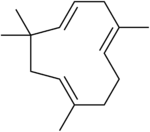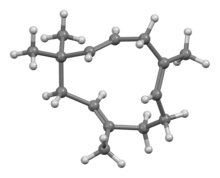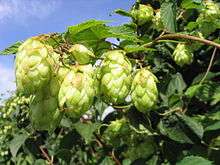Humulene
Humulene, also known as α-humulene or α-caryophyllene, is a naturally occurring monocyclic sesquiterpene (C15H24), containing an 11-membered ring and consisting of 3 isoprene units containing three nonconjugated C=C double bonds, two of them being triply substituted and one being doubly substituted. It was first found in the essential oils of Humulus lupulus (hops), from which it derives its name.[2] Humulene is an isomer of β-caryophyllene, and the two are often found together as a mixture in many aromatic plants.
 | |
 | |
| Names | |
|---|---|
| IUPAC name
(1E,4E,8E)-2,6,6,9-Tetramethyl-1,4-8-cycloundecatriene | |
| Other names
alpha-Caryophyllene; 3,7,10-Humulatriene | |
| Identifiers | |
3D model (JSmol) |
|
| ChEBI | |
| ChEMBL | |
| ChemSpider | |
| ECHA InfoCard | 100.027.106 |
PubChem CID |
|
| UNII | |
CompTox Dashboard (EPA) |
|
| |
| |
| Properties[1] | |
| C15H24 | |
| Molar mass | 204.357 g·mol−1 |
| Appearance | Pale yellowish green clear liquid |
| Density | 0.886 g/cm3 |
| Melting point | < 25 °C (77 °F; 298 K) |
| Boiling point | 106 to 107 °C (223 to 225 °F; 379 to 380 K) at 5 mmHg |
| Hazards | |
| Safety data sheet | MSDS |
| Lethal dose or concentration (LD, LC): | |
LD50 (median dose) |
>48 mg/kg |
Except where otherwise noted, data are given for materials in their standard state (at 25 °C [77 °F], 100 kPa). | |
| Infobox references | |
Occurrence
Humulene is one of the components of the essential oil from the flowering cone of the hops plant, Humulus lupulus, from which it derives its name. The concentration of humulene varies among different varieties of the plant but can be up to 40% of the essential oil.[3] Humulene and its reaction products in the brewing process of beer gives many beers their “hoppy” aroma. Noble hop varieties have been found to have higher levels of humulene, while other bitter hop varieties contain low levels.[4] Multiple epoxides of humulene are produced in the brewing process. In a scientific study involving gas chromatography–mass spectrometry analysis of samples and a trained sensory panel, it was found that the hydrolysis products of humulene epoxide II specifically produces a “hoppy” aroma in beer.[5][6]
α-Humulene has been found in many aromatic plants on all continents, often together with its isomer β-caryophyllene. Proven α-humulene emitters into the atmosphere are pine trees,[7] orange orchards,[8] marsh elders,[9] tobacco,[10] and sunflower fields.[11] α-Humulene is contained in the essential oils of aromatic plants such as Salvia officinalis (common sage, culinary sage),[12] Lindera strychnifolia Uyaku or Japanese spicebush, ginseng species,[13] up to 29.9% of the essential oils of Mentha spicata,[14] the ginger family (Zingiberaceae),[15] 10% of the leaf oil of Litsea mushaensis, a Chinese laurel tree,[16] 4% of the leaf extract of Cordia verbenacea, a bush in coastal tropical South America (erva baleeira), but with 25% trans-Caryophyllene[17] and is one of the chemical compounds that contribute to the taste of the spice Persicaria odorata or Vietnamese coriander and the characteristic aroma of Cannabis.[18]
Preparation and synthesis
Humulene is one of many sesquiterpenoids that are derived from farnesyl diphosphate (FPP). The formation of humulene from FPP is catalyzed by sesquiterpene synthesis enzymes.[19]
This biosynthesis can be mimicked in the laboratory by preparing allylic stannane from farnesol, termed Corey synthesis. There are diverse ways to synthesize humulene in the laboratory, involving differing closures of the C-C bond in the macrocycle. The McMurry synthesis uses a titanium-catalyzed carbonyl coupling reaction; the Takahashi synthesis uses intramolecular alkylation of an allyl halide by a protected cyanohydrin anion; the Suginome synthesis utilizes a geranyl fragment; and the de Groot synthesis synthesizes humulene from a crude distillate of eucalyptus oil.[20] Humulene can also be synthesized using a combination of four-component assembly and palladium-mediated cyclization, outlined below. This synthesis is noteworthy for the simplicity of the C−C bond constructions and cyclization steps, which it is believed will prove advantageous in the synthesis of related polyterpenoids.[21]
To understand humulene's regioselectivity, the fact that one of the two triply substituted C═C double bonds is significantly more reactive, its conformational space was explored computationally and four different conformations were identified.[22]
Research
In laboratory studies, humulene is being studied for potential anti-inflammatory effects.[23][24]
Atmospheric chemistry
α-Humulene is a biogenic volatile organic compound, emitted by numerous plants (see occurrence) with a relatively high potential for secondary organic aerosol formation in the atmosphere. It quickly reacts with ozone in sunlight (photooxidation) to form oxygenated products. α-Humulene has a very high reaction rate coefficient (1.17 × 10−14 cm3 molecule−1 s−1) compared to most monoterpenes. Since it contains three double bonds, first-, second- and third-generation products are possible that can each condense to form secondary organic aerosol. At typical tropospheric ozone mixing ratios of 30 ppb the lifetime of α-humulene is about 2 min, while the first- and second-generation products have average lifetimes of 1 h and 12.5 h, respectively.[25]
References
- Merck Index, 12th Edition, 4789
- Glenn Tinseth, "Hop Aroma and Flavor", January/February 1993, Brewing Techniques. <http://realbeer.com/hops/aroma.html> Accessed July 21, 2010
- Katsiotis, S. T.; Langezaal, C. R.; Scheffe, J. J. C. (1989). "Analysis of the Volatile Compounds from Cones of Ten Humulus lupulus Cultivars". Planta Med. 55 (7): 634. doi:10.1055/s-2006-962205.
- "Archived copy". Archived from the original on 2015-09-24. Retrieved 2011-04-17.CS1 maint: archived copy as title (link)
- Yange, Xiaogen; Lederer, Cindy; McDaniel, Mina; Deinzer, Max. (1993). "Evaluation of hydrolysis products of humulene epoxides II and III". Journal of Agricultural and Food Chemistry. 41 (8): 1300–1304. doi:10.1021/jf00032a026.
- Peackock, Val; Deinzer, Max (1981). "Chemistry of hop aroma in beer". Journal of the American Society of Brewing Chemists. 39. Archived from the original on 2013-12-30.
- D. Helmig; J. Ortega; T. Duhl; D. Tanner; A. Guenther; P. Harley; C. Wiedinmyer; J. Milford; T. Sakulyanontvittaya (2007). "Sesquiterpene emissions from pine trees--identifications, emission rates and flux estimates for the contiguous United States". Environ. Sci. Technol. 41 (5): 1545–1553. Bibcode:2007EnST...41.1545H. doi:10.1021/es0618907. PMID 17396639.
- P. Ciccioli; E. Brancaleoni; M. Frattoni; V. Di Palo; R. Valentini; G. Tirone; G. Seufert; N. Bertin; U. Hansen; O. Csiky; R. Lenz; M. Sharma (1999). "Emission of reactive terpene compounds from orange orchards and their removal by within-canopy processes". J. Geophys. Res. 104 (D7): 8077–8094. Bibcode:1999JGR...104.8077C. doi:10.1029/1998JD100026.
- D. Degenhardt; D. Lincoln, J. (2006). "Volatile Emissions from an Odorous Plant in Response to Herbivory and Methyl Jasmonate Exposure". Chem. Ecol. 32 (4): 725–743. doi:10.1007/s10886-006-9030-2.
- C. De Moraes; M. Mescher; J. Tumlinson (2001). "Caterpillar-induced nocturnal plant volatiles repel conspecific females". Nature. 410 (6828): 577–580. doi:10.1038/35069058. PMID 11279494.
- G. Schuh; A. Heiden; T. Hoffmann; J. Kahl; P. Rockel; J. Rudolph; J. Wildt (1997). "Emissions of Volatile Organic Compounds from Sunflower and Beech: Dependence on Temperature and Light Intensity". J. Atmos. Chem. 27 (3): 291–318. Bibcode:1997JAtC...27..291S. doi:10.1023/A:1005850710257.
- Bouajaj, S; Benyamna, A; Bouamama, H; Romane, A; Falconieri, D; Piras, A; Marongiu, B (2013). "Antibacterial, allelopathic and antioxidant activities of essential oil of Salvia officinalis L. growing wild in the Atlas Mountains of Morocco". Nat Prod Res. 27 (18): 1673–6. doi:10.1080/14786419.2012.751600.
- Cho, IH; Lee, HJ; Kim, YS (Aug 2012). "Differences in the volatile compositions of ginseng species (Panax sp.)". J Agric Food Chem. 60 (31): 7616–22. doi:10.1021/jf301835v.
- Chauhan, SS; Prakash, O; Padalia, RC; Vivekanand, Pant AK; Mathela, CS (2011). "Chemical diversity in Mentha spicata: antioxidant and potato sprout inhibition activity of its essential oils". Nat Prod Commun. 6 (9): 1373–8.
- Suthisut, D; Fields, PG; Chandrapatya, A (2011). "Contact toxicity, feeding reduction, and repellency of essential oils from three plants from the ginger family (Zingiberaceae) and their major components against Sitophilus zeamais and Tribolium castaneum". J Econ Entomol. 104 (4): 1445–54. doi:10.1603/ec11050.
- Ho, CL; Wang, EI; Tseng, YH; Liao, PC; Lin, CN; Chou, JC; Su, YC (2010). "Composition and antimicrobial activity of the leaf and twig oils of Litsea mushaensis and L. linii from Taiwan". Nat Prod Commun. 5 (11): 1823–8.
- de Carvalho, Jr.; Rodrigues, R.F.; Sawaya, A.C.; Marques, M.O.; Shimizu, M.T. (2004). "Chemical composition and antimicrobial activity of the essential oil of Cordia verbenacea D.C". Journal of Ethnopharmacology. 95 (2–3): 297–301. doi:10.1016/j.jep.2004.07.028.
- Hillig, Karl W (October 2004). "A chemotaxonomic analysis of terpenoid variation in Cannabis". Biochemical Systematics and Ecology. 32 (10): 875–891. doi:10.1016/j.bse.2004.04.004. ISSN 0305-1978.
- Moss, G.P., "Humulene derived sesquiterpenoid biosynthesis." International Union of Biochemistry and Molecular Biology Enzyme Nomenclature. Accessed April 10, 2011. http://www.enzyme-database.org/reaction/terp/humul.html
- Goldsmith, David. "The total synthesis of natural products". Canada: John Wiley & Sons. 1997 pp 129-133
- Hu, Tao & Corey, E.J. (2002). "Short Syntheses of (±)-δ-Araneosene and Humulene Utilizing a Combination of Four-Component Assembly and Palladium-Mediated Cyclization". Organic Letters. 4 (14): 2441–2443. doi:10.1021/ol026205p. PMID 12098267.CS1 maint: multiple names: authors list (link)
- Neuenschwander, U; et al. (2012). "Origin of Regioselectivity in α-Humulene Functionalization". J. Org. Chem. 77 (6): 2865–2869. doi:10.1021/jo3000942.
- Passosa, G.F.; Fernandesa, ES.; et al. (2007). "Anti-inflammatory and anti-allergic properties of the essential oil and active compounds from Cordia verbenacea". Journal of Ethnopharmacology. 110 (2): 323–333. doi:10.1016/j.jep.2006.09.032. PMID 17084568.
- Fernandes E.S.; Passos G.F.; Medeiros R.; da Cunha F.M.; Ferreira J.; Campos M.M.; Pianowski L.F.; Calixto J.B. (2007). "Anti-inflammatory effects of compounds alpha-humulene and (−)-trans-caryophyllene isolated from the essential oil of Cordia verbenacea". European Journal of Pharmacology. 569 (3): 228–236. doi:10.1016/j.ejphar.2007.04.059. PMID 17559833.
- Beck, M.; Winterhalter, R.; Herrmanna, F.; Moortgat, G. K. (2011). "The gas-phase ozonolysis of α-humulene". Phys. Chem. Chem. Phys. 13 (23): 10970–11001. Bibcode:2011PCCP...1310970B. doi:10.1039/c0cp02379e.

